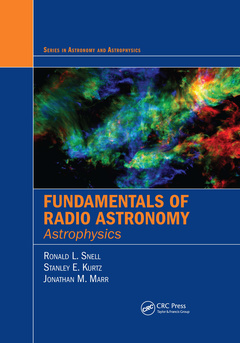Fundamentals of Radio Astronomy Astrophysics Series in Astronomy and Astrophysics Series
Auteurs : Snell Ronald L., Kurtz Stanley, Marr Jonathan

As demonstrated by five Nobel Prizes in physics, radio astronomy has contributed greatly to our understanding of the Universe. Courses covering this subject are, therefore, very important in the education of the next generation of scientists who will continue to explore the Cosmos.
This textbook, the second of two volumes, presents an extensive introduction to the astrophysical processes that are studied in radio astronomy. Suitable for undergraduate courses on radio astronomy, it discusses the physical phenomena that give rise to radio emissions, presenting examples of astronomical objects, and illustrating how the relevant physical parameters of astronomical sources can be obtained from radio observations.
Unlike other radio astronomy textbooks, this book provides students with an understanding of the background and the underlying principles, with derivations available for most of the equations used in the textbook.
Features:
- Presents a clear and concise discussion of the important astronomical concepts and physical processes that give rise to both radio continuum and radio spectral line emission
- Discusses radio emissions from a variety of astronomical sources and shows how the observed emissions can be used to derive the physical properties of these sources
Includes numerous examples using actual data from the literature
1. Introduction. 2. Propagation of Radiation. 3. Continuum Emission Processes. 4. Spectral Lines. 5. The Cold Interstellar Medium of the Milky Way. 6. HII Regions and Planetary Nebulae at Radio Wavelengths. 7. Radio Emission from Stellar Objects. 8. Galaxies at Radio Wavelengths. 9. Radio Galaxies and Quasars. 10.Cosmic Microwave Background. Appendices.
Ronald L. Snell is a professor of astronomy at the University of Massachusetts, Amherst. His research interests include the physical and chemical properties of molecular clouds, star formation, and molecular outflows; he also has extensive experience observing at radio wavelengths. He earned a PhD in astronomy from the University of Texas at Austin.
Stanley E. Kurtz is a professor of radio astronomy and astrophysics at the National Autonomous University of Mexico. His research interests include massive star formation, the interstellar medium, and radio astronomy instrumentation and techniques. He earned a PhD in physics from the University of Wisconsin at Madison.
Jonathan M. Marr is a senior lecturer of physics and astronomy at Union College. His research involves high-resolution, radio-wavelength observations of radio galaxies and the Galactic center. He earned a PhD in astronomy from the University of California, Berkeley.
Date de parution : 03-2021
17.8x25.4 cm
Date de parution : 05-2019
17.8x25.4 cm
Thèmes de Fundamentals of Radio Astronomy :
Mots-clés :
HII Region; Flux Density; Brightness Temperature; Optical Depth; Column Density; Energy Density; Molecular Cloud; CMB Power Spectrum; Synchrotron Radiation; Galactic Longitude; Excitation Temperature; Galactic Center; Molecular Gas; Rotation Curve; LCP Wave; AGN; Radio Galaxies; CMB Photon; Cosmic Microwave Background; CMB; Star Formation Rate; Free Free Emission; Solar Radio Emission; Stellar Mass; Early Type Galaxies



